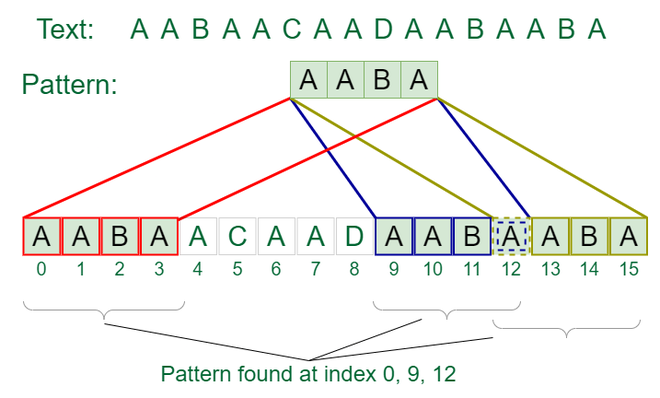Knuth-Morris-Pratt (KMP) Algorithm (Geeks for Geeks)
1. What is the Knuth-Morris-Pratt (KMP) Algorithm?
The Knuth-Morris-Pratt (KMP) algorithm is an efficient pattern matching algorithm that searches for occurrences of a within a main by employing the observation that when a mismatch occurs, the word itself embodies sufficient information to determine where the next match could begin, thus bypassing re-examination of previously matched characters.
2. Algorithm for Knuth-Morris-Pratt (KMP)
- Preprocess the pattern to create an array (LPS array) that stores the length of the longest prefix which is also a suffix.
- Use the to skip characters while matching.
3. How does the Knuth-Morris-Pratt (KMP) Algorithm work?
- The KMP algorithm preprocesses the pattern to determine the longest prefix which is also a suffix in the pattern itself.
- This preprocessing is used to avoid unnecessary re-evaluation of the characters in the text, making the search process more efficient.
4. Problem Description
Given a text string and a pattern string, implement the algorithm to find all occurrences of the pattern in the text.
5. Examples
Example 1:
Input: text = "ABABDABACDABABCABAB", pattern = "ABABCABAB"
Output: Pattern found at index 10
Example 2:
Input: text = "AABAACAADAABAABA", pattern = "AABA"
Output: Pattern found at index 0, Pattern found at index 9, Pattern found at index 12
Explanation of Example 1:
- The pattern "ABABCABAB" is found in the text "ABABDABACDABABCABAB" starting from index 10.
Visual Example

6. Constraints
- The text and pattern can contain any number of characters.
- All characters are characters.
7. Implementation
- Python
- C++
- Java
- JavaScript
def KMPSearch(pat, txt):
M = len(pat)
N = len(txt)
lps = [0] * M
j = 0
computeLPSArray(pat, M, lps)
i = 0
while i < N:
if pat[j] == txt[i]:
i += 1
j += 1
if j == M:
print("Found pattern at index " + str(i - j))
j = lps[j - 1]
elif i < N and pat[j] != txt[i]:
if j != 0:
j = lps[j - 1]
else:
i += 1
def computeLPSArray(pat, M, lps):
length = 0
lps[0] = 0
i = 1
while i < M:
if pat[i] == pat[length]:
length += 1
lps[i] = length
i += 1
else:
if length != 0:
length = lps[length - 1]
else:
lps[i] = 0
i += 1
# Example usage:
text = "ABABDABACDABABCABAB"
pattern = "ABABCABAB"
KMPSearch(pattern, text)
#include <iostream>
#include <vector>
using namespace std;
void computeLPSArray(string pat, int M, vector<int>& lps) {
int length = 0;
lps[0] = 0;
int i = 1;
while (i < M) {
if (pat[i] == pat[length]) {
length++;
lps[i] = length;
i++;
} else {
if (length != 0) {
length = lps[length - 1];
} else {
lps[i] = 0;
i++;
}
}
}
}
void KMPSearch(string pat, string txt) {
int M = pat.size();
int N = txt.size();
vector<int> lps(M);
computeLPSArray(pat, M, lps);
int i = 0;
int j = 0;
while (i < N) {
if (pat[j] == txt[i]) {
i++;
j++;
}
if (j == M) {
cout << "Found pattern at index " << (i - j) << endl;
j = lps[j - 1];
} else if (i < N && pat[j] != txt[i]) {
if (j != 0) {
j = lps[j - 1];
} else {
i++;
}
}
}
}
int main() {
string txt = "ABABDABACDABABCABAB";
string pat = "ABABCABAB";
KMPSearch(pat, txt);
return 0;
}
public class KMPAlgorithm {
void KMPSearch(String pat, String txt) {
int M = pat.length();
int N = txt.length();
int lps[] = new int[M];
int j = 0;
computeLPSArray(pat, M, lps);
int i = 0;
while (i < N) {
if (pat.charAt(j) == txt.charAt(i)) {
i++;
j++;
}
if (j == M) {
System.out.println("Found pattern at index " + (i - j));
j = lps[j - 1];
} else if (i < N && pat.charAt(j) != txt.charAt(i)) {
if (j != 0)
j = lps[j - 1];
else
i++;
}
}
}
void computeLPSArray(String pat, int M, int lps[]) {
int len = 0;
int i = 1;
lps[0] = 0;
while (i < M) {
if (pat.charAt(i) == pat.charAt(len)) {
len++;
lps[i] = len;
i++;
} else {
if (len != 0) {
len = lps[len - 1];
} else {
lps[i] = 0;
i++;
}
}
}
}
public static void main(String args[]) {
String txt = "ABABDABACDABABCABAB";
String pat = "ABABCABAB";
new KMPAlgorithm().KMPSearch(pat, txt);
}
}
function KMPSearch(pat, txt) {
const M = pat.length;
const N = txt.length;
const lps = new Array(M).fill(0);
computeLPSArray(pat, M, lps);
let i = 0;
let j = 0;
while (i < N) {
if (pat[j] === txt[i]) {
i++;
j++;
}
if (j === M) {
console.log("Found pattern at index " + (i - j));
j = lps[j - 1];
} else if (i < N && pat[j] !== txt[i]) {
if (j !== 0) {
j = lps[j - 1];
} else {
i++;
}
}
}
}
function computeLPSArray(pat, M, lps) {
let length = 0;
let i = 1;
lps[0] = 0;
while (i < M) {
if (pat[i] === pat[length]) {
length++;
lps[i] = length;
i++;
} else {
if (length !== 0) {
length = lps[length - 1];
} else {
lps[i] = 0;
i++;
}
}
}
}
// Example usage:
const text = "ABABDABACDABABCABAB";
const
pattern = "ABABCABAB";
KMPSearch(pattern, text);
8. Complexity Analysis
-
Time Complexity:
- Preprocessing the LPS array:
- Searching the pattern in the text:
- Overall:
-
Space Complexity: for the LPS array.
9. Advantages and Disadvantages
Advantages:
- More efficient than the naive pattern matching algorithm, especially for large texts.
- Avoids redundant comparisons.
Disadvantages:
- Slightly more complex to implement than naive algorithms.
- Requires additional space for the LPS array.
10. References
- GFG Problem: GFG Problem
- HackerRank Problem: HackerRank
- Author's Geeks for Geeks Profile: MuraliDharan